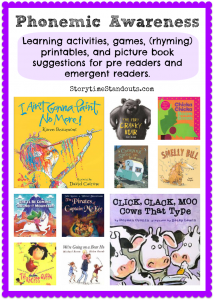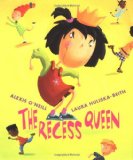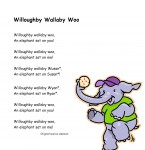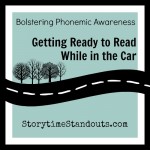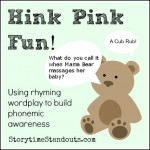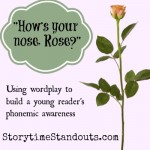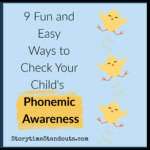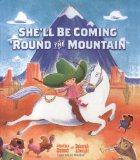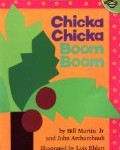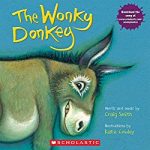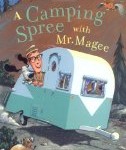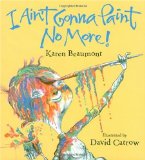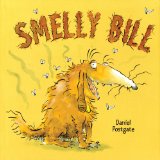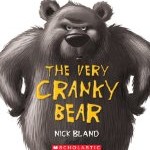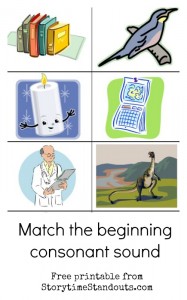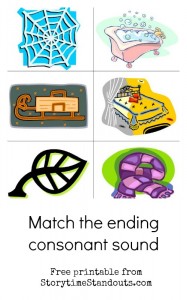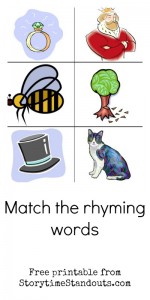Rhyming and Phonemic Awareness
Phonemic Awareness activities, games and picture books help pre-readers and emergent readers learn about sounds in spoken words including rhyming and alliteration.
“One of the most compelling and well-established findings in the research on beginning reading is the important relationship between phonemic awareness and reading acquisition.”
(Kame’enui, et. al., 1997)

Scroll down to find Phonemic Awareness Resources
– Activities to Support Phonemic Awareness
– Match the Consonant Sounds Printables
– Rhyming Word Printables
Ways for parents and teachers to support the development of phonemic awareness in young children #learningtoread #teachingreading #phonemicawareness #freeprintables Share on X
Phonemic Awareness is
- The understanding that words are made up of sounds
- The ability to pick out and manipulate sounds in spoken words
- Together with alphabet recognition, a key to early reading success
- Developed in part by listening to rhymes, rhyming words, poetry, songs and wordplay
We suggest using these learning games and activities with young children especially preschool and kindergarten aged children. Phonemic awareness activities help prepare children for reading, spelling and writing. Phonemic Awareness is not related to print. Your child will not need a pencil, paper or books to develop phonemic awareness. Phonemic Awareness can be improved anywhere, anytime. Your child’s phonemic awareness skills can improve while you are talking together or while sharing stories, poetry and rhymes.
Phonemic Awareness Tasks are Mainly Oral
Is your child able to hear rhymes and/or alliteration?
- in poetry: Hickory dickory dock The mouse ran up the clock
- in songs: Rain, rain go away, Come again on another day
- in nonsense: She sells sea shells down by the sea shore.
- Could your child tell you that king and ring are rhyming words?
- Can your child hear that the words in ‘blue balls bounce’ all begin with the same sound?
Could your child…
- Listen to three words, and hear the one that does not rhyme?
- Look at items on a tray and identify the item that begins with a different sound?
- Listen to a story about Cathy. ‘Cathy likes cookies, candy and cake.’ Could your child say whether Cathy would she prefer crayons or pencils? Camping or hiking?
And, could he or she blend sounds together and create words?
- Listen to the word parts (syllables), say the word. The first part is air… the second part is port. What is the whole word?
- The first part of the word is /r/. The second part of the word is ug. What is the whole word?
- Listen to the word parts, /h/ /u/ /g/. What is the word?
- Conversely, could he or she orally segment words?
- What sounds do you here in cat? /c/ /a/ /t/
Activities You Can Use to Promote Phonemic Awareness
- Read poetry!
- Read and enjoy lots of rhyming stories like Jillian Jiggs
or A Camping Spree With Mr. Magee
with your child. Another time, when you reread the stories, pause when you come to the matching rhymes, see if your child can ‘fill in the blanks.’
- Play with Hink Pinks. A Hink Pink is a pair of rhyming words that answer a riddle. For example, a large hog is a Big Pig, a fight over a baby’s toy is a Rattle Battle.
- Twist Your Tongue – Have fun with tongue twisters like Rubber baby buggy bumpers and Peter Piper picked a peck of pickled peppers! Help your child to make up silly alliterative sentences.
- Make up an unusual list – ‘I’m going camping and I’m going to pack a bat, a cat, a rat.’ OR ‘I’m going camping and I’m going to pack a sock, a sleeping bag, a soccer ball, and a sandwich. Do you think I will want a sweater or a jacket?’ Ask your child to suggest some more things for your list. Can your child hear how your words work together?
- Make a poster or a book – create a book of words that begin with a particular sound or create a book of rhyming words
- Play I spy with my little eye, something that begins with /s/ (use the letter sound rather than the letter name)
- Clap to the beat of songs and poems
- How many rhyming words can you make up? (nonsense is okay)
- Sort picture cards into rhyming families
- Make up word riddles – what starts with /b/ and rhymes with red?
Songs, Rhymes and Chants You Can Use to Promote Phonemic Awareness
Step 1 – Make sure you have Adobe Reader. If you don’t have it, please click on the ‘Get Adobe Reader’ button to install it for free.
Step 2 – Pin this page, bookmark this page, share this page or “Like” us on Facebook.
Step 3 – Choose from any of our 250 free downloads, including these free printables that support phonemic awareness.
 I've Been Working on the Railroad
I've Been Working on the Railroad
Lyrics for the traditional song include 'Fee–fi-fid–lee-i-o, Fee–fi-fid–lee-i-o,
Fee–fi-fid–lee-i-o'
Switch up the initial consonant sound to help children develop phonemic awareness:
'Ree–ri-rid–lee-i-o, Ree–ri-rid–lee-i-o,
Ree–ri-rid–lee-i-o'
 We're Going on a Bear Hunt
We're Going on a Bear Hunt
Predictable text, rhyming and opportunities for dramatic play make the We're Going on a Bear Hunt chant a favorite with children.
 There Was An Old Lady Who Swallowed a Fly
There Was An Old Lady Who Swallowed a Fly
Traditional repetitive rhyme
 Willoughby Wallaby Woo
Willoughby Wallaby Woo
Willoughby Wallaby Woo is a fun chant - a great way to help a child develop phonemic awareness.
 Grandma's House
Grandma's House
Lots of rhyming and repetition make Grandma's House a great choice for preschool or kindergarten Circle Time.
 Pop Pop Pop
Pop Pop Pop
Pop Pop Pop is a fun action chant for preschool.
 Jelly in the Bowl
Jelly in the Bowl
Alliteration, wordplay and repetition in this chant. Great for helping children to develop phonemic awareness
 Old MacDonald Had A Farm
Old MacDonald Had A Farm
Lyrics for the traditional song - change it up a bit and help children develop phonemic awareness.
'And on that farm he had a sheep, SHEE-SHI-SHEE-SHI-SHO'
 Apples and Bananas
Apples and Bananas
Apples and Bananas is a traditional children's song that plays with vowel sounds. A great way to promote Phonemic Awareness in preschool and kindergarten.
 If You're Happy and You know It - Consonant Sounds
If You're Happy and You know It - Consonant Sounds
The traditional song adapted to introduce and reinforce consonant sounds.
Some of our Most Popular Phonemic Awareness Recognition Posts
Hover over the photo for a description of the activity. Click on the photo to read the full post
Picture Books You Can Use to Promote Phonemic Awareness
A Camping Spree with Mr. Magee – written and Illustrated by Chris Van Dusen
Rhyming Picture Book published by Chronicle Books
An absolutely irresistible adventure story for young children. A Camping Spree With Mr. Magee is one of my all-time favourite picture books. When Mr. Magee and his small dog begin their camping trip, they have no inkling that a near-sighted, marshmallow-fancying bear will soon have them staring down a fifty foot waterfall.
They were snoring and snoozing, enjoying a dream, When splash went the camper right into the stream! The splash shook the camper. They jumped out of bed. “Now what in the world was that?” Magee said. Read more here
I Ain’t Gonna Paint No More written by Karen Beaumont and illustrated by David Catrow
Rhyming picture book published by HMH Books for Young Readers
With delightful, exuberant illustrations and equally fun text, you and your child will thoroughly enjoy this irresistible romp. Watch and sing along as a young child paints himself (and much of his home) from top to bottom.
So I take some red and I paint my…
Head! Now I ain’t gonna paint no more.
Aw, what the heck! Gonna paint my…
Neck! Now I ain’t gonna paint no more.Read more here
The Pirates of Captain McKee! written by Julie Lawson and illustrated by Werner Zimmermann
Rhyming picture book published by Scholastic Canada
Originally published as Whatever You Do, Don’t Go Near that Canoe, The Pirates of Captain McKee is a rollicking adventure story that will have broad appeal to young children, especially those who love pirates.
A nominee for The 1996 Canada Council for the Arts Governor General’s Literacy Award for illustration, The Pirates of Captain McKee tells the story of two children, a brother and sister, who are warned not to go near a canoe. The warning, given by Captain Kelsey McKee, is accompanied by a wink so the children are undeterred. They don lifejackets and climb into the canoe. Before long they find themselves well away from the dock.
Through fast-running currents, through slow-rolling tides, Far into the fading light, Through sun flecks and sunset, through dusk’s purple haze,
The canoe sped into the night.Read more here
Smelly Bill written and illustrated by Daniel Postgate
Rhyming picture book published by Albert Whitman & Company
Oh yuk, Smelly Bill is one mucky dog. He loves to roll in mud and rubbish. He steadfastly resists his family’s attempts to de-reek him! When Great Aunt Bleach arrives, she brings her disinfectant and scrub brush. Before long the house is sparkling from top to uh-oh – what is that smell? After a merry chase, Bill endures his bathie-wathie, and makes a mess of poor Great Aunt Bleach. With wonderful rhyming text and fun illustrations, Smelly Bill will be enjoyed by children of all ages. Read more here
The Very Cranky Bear written and illustrated by Nick Bland
Rhyming picture book published by Scholastic
What a delight! Four young animal friends decide a dry but dark cave is the perfect place to take shelter from a downpour. They have just settled into a sociable game of cards when a weary, bad-tempered bear chases them out of the cave and into the rain. Three of the pals decide that the bear’s misery must be due to his rather nondescript appearance. When their ill-advised makeover does nothing to improve the bear’s mood, Read more here
Phonemic Awareness and Rhyming Printables
Step 1 – Make sure you have Adobe Reader. If you don’t have it, please click on the ‘Get Adobe Reader’ button to install it for free.
Step 2 – Pin this page, bookmark this page, share this page or “Like” us on Facebook.
Step 3 – Choose from any of our 250 free downloads, including these free printables that support phonemic awareness.
Match the Beginning Consonant Sound

 Match the Beginning Consonant Sound
Match the Beginning Consonant Sound
Cut the pictures apart and have children match the initial consonant sound - a great way to support the development of phonemic awareness.
Match the Ending Consonant Sound
 Match the Ending Consonant Sound
Match the Ending Consonant Sound
Another way to help children develop phonemic awareness. Matching the ending consonant sound is more difficult than matching the beginning consonant sound.

Match the Rhyming Words
 Match the Rhyming Words
Match the Rhyming Words
24 Pictures of rhyming words (king, ring, bee, tree, hat, cat, mouse, house, bed, red, clock, lock, tire, fire, bear, chair, train, chain, skate, gate, fox, box, frog, dog)
 Match the Rhyming Words - Set 2
Match the Rhyming Words - Set 2
24 pictures of rhyming words (whale, sail, hook, book, wig, pig, stamp, lamp, wet, jet, five, hive, hair, stair, fish, dish, flower, tower, clip, hip, moose, goose, ghost, toast)



